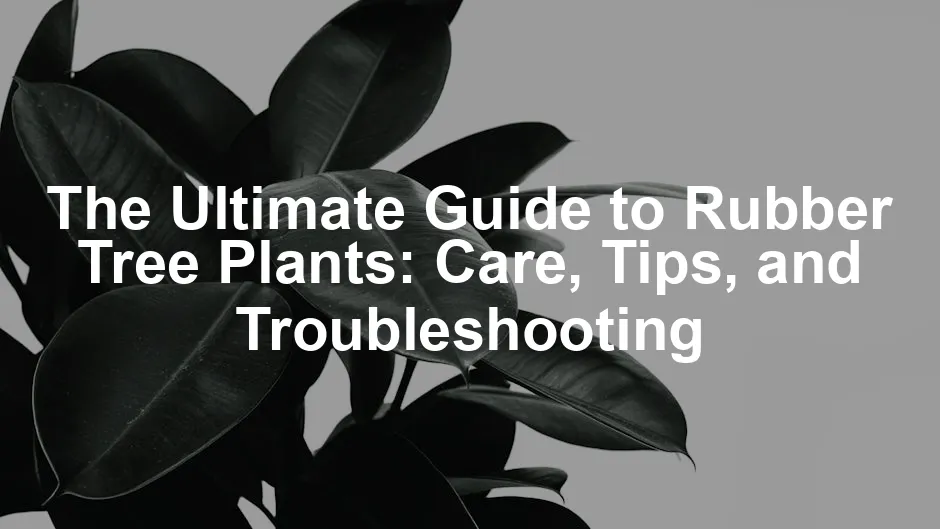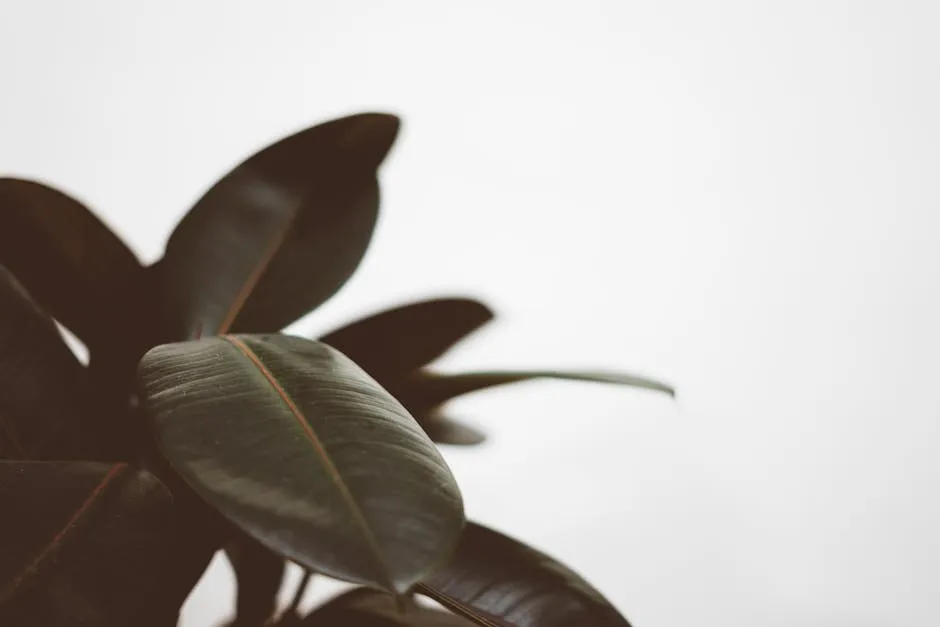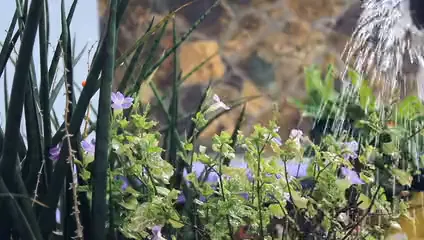

The Ultimate Guide to Rubber Tree Plants: Care, Tips, and Troubleshooting
Introduction
The rubber tree plant (Ficus elastica) has become a favorite for many indoor gardeners. Its striking glossy leaves add a touch of elegance to any space. Plus, it’s easy to care for, making it perfect for both newbies and seasoned plant lovers. Whether you’re looking to spruce up your home or office, this plant is sure to impress.
To keep your rubber tree thriving, you might want to consider using a high-quality indoor potting mix. This will give your plant the nutrients it needs to flourish while ensuring proper drainage. After all, no one wants their rubber tree to feel like it’s drowning in soggy soil!

Summary and Overview
Originating from India and tropical Asia, the rubber tree plant is known for its stunning appearance and versatility. Its thick, dark green leaves can grow quite large, creating a bold statement in any room. Some varieties even feature unique variegation, adding to their appeal. The rubber tree is often used for decorative purposes, as well as for its air-purifying qualities.
Understanding how to care for this plant is key to ensuring its health and growth. Rubber trees thrive in bright, indirect light and appreciate consistent watering. They can grow quite tall, often reaching heights of 10 feet or more indoors. With proper attention to their needs, these plants can flourish, bringing life and vibrancy to your home.

Care Requirements for Rubber Tree Plants
Potting Your Rubber Tree
Choosing the right pot is crucial for your rubber tree plant’s health. Aim for a pot that’s slightly bigger than the root ball. Ideally, a pot should provide at least two inches of space around the plant. This allows for healthy root growth.
Always select a pot with drainage holes. These holes prevent water from accumulating, which can lead to root rot. Rubber trees prefer well-draining soil. A high-quality indoor potting mix works well, but you can enhance it by adding perlite. This addition improves aeration and drainage. To make your life easier, grab some perlite for your plants so you never have to worry about drainage issues again!
When repotting, do it during the growing season, typically spring or early summer. Gently remove the plant from its old pot and shake off excess soil. Place it in the new pot, ensuring it’s centered and straight. After potting, water it thoroughly, allowing excess to drain. This will help settle the soil around the roots.

Light Requirements
Rubber trees thrive in bright, indirect light. Position your plant near a window that doesn’t receive harsh, direct sunlight. Too much direct light can scorch the leaves, while insufficient light can cause leggy growth. If your rubber tree starts stretching, it may be reaching for more light.
Seasonal adjustments are essential. In winter, when light levels drop, consider moving your plant to a brighter spot. If you notice browning leaf tips, it might be getting too much light. Dust can also hinder light absorption, so clean the leaves regularly with a damp cloth.
Finding the perfect spot for your rubber tree will help it flourish. Remember, the right lighting is key to its health and vibrancy. And if you’re looking to enhance that lighting, check out a grow light for your indoor plants. It can make all the difference!
Watering Guidelines
Establishing a proper watering routine is vital for rubber tree care. Allow the top few inches of soil to dry out between waterings. If the leaves begin to droop, your plant is thirsty. On the other hand, yellowing leaves often indicate overwatering.
A good rule of thumb is to water every 1-2 weeks, depending on your environment. Adjust this frequency based on humidity and temperature. Always water deeply until it drains from the bottom. Discard any excess water in the saucer to prevent root rot.
Maintaining consistent soil moisture is essential. During the growing season, rubber trees may require more frequent watering. In contrast, during the winter months, you can reduce watering. Keep an eye on your plant to ensure it stays happy and healthy. And why not make watering a breeze with a stylish watering can that has measurements? It’ll help you keep track of how much your green friend is drinking!

Fertilizing Your Rubber Tree
Fertilizing your rubber tree helps promote healthy growth, especially during the growing season. Use a balanced liquid fertilizer with an NPK ratio of 10-10-10 or similar. Apply it every 4-6 weeks during spring and summer.
Be cautious not to over-fertilize. If you notice brown leaf tips, this could be a sign of too much fertilizer. If this happens, flush the soil with water to remove excess nutrients. During the fall and winter, you can reduce or stop fertilization since the plant’s growth slows down.
Regular feeding keeps your rubber tree vigorous and lush. By monitoring its response to fertilizer, you can ensure it thrives in your home. And if you want to make things easier, grab some balanced liquid fertilizer to help your plant flourish!

Pruning Techniques
Pruning your rubber tree plant is essential for both growth and shape. Regular pruning encourages a bushier appearance and prevents the plant from becoming too tall. To start, prune during the growing season, ideally in spring or early summer. This timing allows for quick recovery and new growth.
When pruning, focus on removing leggy stems or any yellowing leaves. Use clean, sharp pruning shears to make precise cuts. To encourage bushier growth, pinch off the tips of new growth. This technique stimulates branching and creates a fuller look.
If your rubber tree becomes too tall, consider cutting back the main stem. This not only controls height but can also promote healthier growth. After pruning, always monitor your plant for signs of stress, like excessive leaf drop. With the right techniques, your rubber tree will thrive and maintain a beautiful shape.

Common Issues and Troubleshooting
Leaf Drop and Yellowing
Leaf drop and yellowing leaves are common concerns for rubber tree enthusiasts. Several factors can cause these issues. Environmental shock from moving the plant often leads to leaf drop. Overwatering is another culprit, as it suffocates roots and causes yellowing.
To recover your plant, first check the soil moisture. If it’s too wet, adjust your watering schedule and allow the soil to dry out. Conversely, if the leaves are drooping, your plant may be thirsty. Ensure you’re watering deeply but not too frequently.
Light conditions also play a significant role. If your rubber tree is in low light, it may drop leaves. Consider moving it to a brighter spot with indirect sunlight. Keep a close eye on your plant’s health, and make adjustments as needed to prevent further issues.

Pest Management
Pests can pose a significant threat to the health of your rubber tree. Common pests include spider mites, aphids, and mealybugs. Look for signs of infestation such as tiny webs, sticky residue, or visible bugs on the leaves.
To manage pests, start with natural remedies. A mixture of water and mild soap can effectively eliminate many pests. Spray this solution on the affected areas, ensuring full coverage. For heavier infestations, consider neem oil as a treatment option.
Preventive measures are essential to keep your rubber tree healthy. Regularly inspect your plant for signs of pests and maintain good air circulation. Cleaning the leaves with a damp cloth can also deter pests by removing dust and debris. By staying vigilant, you can keep your rubber tree thriving and pest-free.

Propagation Techniques
Propagating a rubber tree plant is simple and rewarding. You can use cuttings or water propagation techniques to grow new plants. For cuttings, select a healthy stem with a few leaves. Cut just below a node, where new roots will form. Trim the leaves to reduce moisture loss, then place the cutting in a pot with well-draining soil.
Alternatively, you can start your cutting in water. Place the cut end in a jar of water, ensuring the node is submerged. Change the water weekly to keep it fresh. In a few weeks, you’ll see roots developing. Once they’re a few inches long, transplant the cutting into soil for continued growth.
For the best results during propagation, consider using a plant propagation station. This handy tool will help you monitor your new plants’ growth while keeping them stylish!
Caring for your newly propagated plants is essential. Keep them in bright, indirect light and maintain consistent moisture. Avoid overwatering, as this can lead to root rot. Monitor the soil and water only when the top layer feels dry.
Timing is also crucial. Spring and early summer are the best seasons for propagation, as plants are actively growing. By following these techniques, you’ll have healthy rubber tree plants in no time.

FAQs
What is the best location for a rubber tree plant in my home?
The best location for a rubber tree plant is near a window with bright, indirect light. Avoid direct sunlight, which can scorch the leaves. Make sure it’s away from drafts or heating vents, as these can stress the plant. Finding the right spot will help your rubber tree thrive!
How often should I water my rubber tree?
Establishing a consistent watering schedule is essential for your rubber tree’s health. Aim to check the soil moisture regularly. The top two inches should feel dry before you water again. If you notice drooping leaves, your plant is thirsty. Conversely, yellowing leaves may indicate overwatering. A good rule is to water every 1-2 weeks. This can vary based on your home’s temperature and humidity. During warmer months, your rubber tree may need more frequent watering. In winter, reduce the frequency. Always water thoroughly until it drains from the bottom. Discard any excess water to avoid root rot. By following this routine, your rubber tree will thrive.
Can rubber tree plants be toxic to pets?
Yes, rubber tree plants can be toxic to pets. The milky sap contains compounds that may cause mild irritation. Dogs and cats may experience stomach upset if they chew on the leaves. Symptoms can include drooling, vomiting, or diarrhea. If you suspect your pet has ingested any part of the rubber tree, contact your veterinarian. Always keep toxic plants out of reach from curious pets. By being aware of rubber tree toxicity, you can ensure a safe environment for your furry friends.
Why are the leaves on my rubber tree turning brown?
Browning leaves can be a sign of several issues in rubber tree care. First, check the watering habits. Underwatering often causes leaf tips to brown. If the soil feels dry, give your plant a good drink. On the other hand, overwatering can also lead to browning leaves. If the soil is soggy, roots may rot, affecting leaf health. Another common cause is excessive direct sunlight, which can scorch the leaves. Ensure your rubber tree is in bright, indirect light. Keep an eye on humidity levels, too. Low humidity can make leaves crispy. By adjusting your care routine, you can restore your rubber tree’s health.
How can I encourage my rubber tree to grow taller?
If you want to promote rubber tree growth, consider a few key factors. First, ensure your plant receives bright, indirect light. This encourages healthy, upward growth. If light is insufficient, your plant may become leggy. Regular watering is also crucial. Maintain consistent soil moisture, allowing the top few inches to dry out between waterings. Proper nutrients can help, too. Fertilize during the growing season with a balanced fertilizer every 4-6 weeks. This supports robust growth. Lastly, pruning can stimulate height. Trim back any leggy or unhealthy growth to encourage new, vertical shoots. With these strategies, your rubber tree can reach impressive heights.
What soil is best for rubber tree plants?
Choosing the best soil for rubber tree planting is vital for success. Rubber trees prefer well-draining soil. An all-purpose indoor potting mix works well, but consider adding perlite or coco coir. These materials improve aeration and drainage. Ensure your pot has drainage holes to prevent water from pooling. This helps avoid root rot, a common issue for rubber trees. You can also mix in some orchid bark for added drainage. This combination will create a healthy environment for your plant’s roots. With the right soil, your rubber tree will thrive, showcasing its beautiful leaves and growth potential.
How do I clean the leaves of my rubber tree plant?
Cleaning leaves is an important part of rubber tree maintenance. Dust and debris can block sunlight, hindering photosynthesis. Use a damp cloth or sponge to gently wipe the leaves. This will help them stay healthy and vibrant. If your rubber tree has large leaves, consider using a soft spray of water to rinse them. Be sure to avoid any cold drafts, as this can shock the plant. Cleaning leaves regularly also helps you spot any pests early on. Maintaining clean leaves will enhance your plant’s appearance and overall health. Your rubber tree will thank you for the extra care!
If you found these tips helpful, consider subscribing for more plant care insights! Got questions or experiences to share? Drop a comment below and let’s chat! Don’t forget to share this article with fellow plant enthusiasts on social media!
And for the ultimate plant care experience, consider investing in a plant care guide book to deepen your knowledge about all things green!
Please let us know what you think about our content by leaving a comment down below!
Thank you for reading till here 🙂
For more insights on indoor gardening, check out this article on how to cultivate beautiful orchids for indoor gardening.
All images from Pexels



